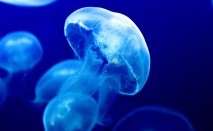
Category: Invertebrates
Crinoids, aptly nicknamed “feather stars”, can inhabit a wide range of marine environments and, judging by the fossil record, were very abundant organisms in the past, especially in the mid- to late-Paleozoic. They usually have a stem to attach themselves to a substrate but many only live attached as juveniles and spend most of their lives as free-swimming entities. They obtain nutrition by filtering small particles of food from the water using the mucous covered tube feet covering their feathery arms. Though they display the five-fold symmetry typical of echinoderms, some crinoids can have as many as two hundred arms!

The world’s first Animals
Invertebrates were the first animals to evolve. While their soft bodies left precious few records behind, there are fossils of sponge-like animals that are 665 million years old, as well as traces of tracks and burros from worm-like animals going back 1 billion years. By comparison, the earliest birds appeared only 150 million years ago! And not only were invertebrates first, they are the most plentiful of animals - it is estimated that 97% of all animals living on the Earth today are invertebrates, with several groups containing more species than all vertebrates combined!
Learn more >>
 Discover Animals is a web-based educational resource offered by the NAIA
Discover Animals is a web-based educational resource offered by the NAIA